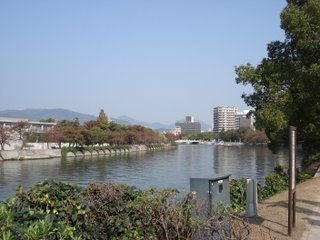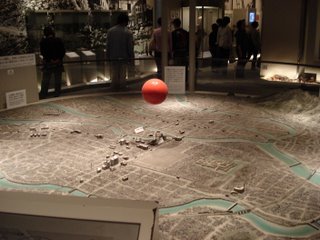
Hiroshima. I went there with Tim and Chris weekend before last. It's strange to think about. 60 years ago America dropped the first atomic bomb to end WWII. Now, americans come here as tourists.
They've built a park around the epicenter of the blast,, beautiful really. There are various monuments and statues, but the most well known is the 'a-bomb dome', one of the few structures that remained standing within one kilometer of the blast. They've left it mostly untouched (with a few reenforcment beams included now to assure it will remain standing). It's a powerful statement, ruined among the well kept grounds of the park.



There was also the children's peace monument, dedicated largely to Sadako Sasaki, who died of lukemia before she was able to finish making 1000 paper (oragami) cranes. Now there strings and bags of paper cranes throughout the entire park. We saw this school group come to the monument while we were there,, they were singing something at the monument. I don't know what it was,,, I would assume it was some kind of dedication of some sort (if I ever figure out how to post video on this site, I'll put it up).


There was also this flame in the center of the park (and it was placed in a much more astetically pleasing fashion than this camera angle would suggest). If I read the signs right, it's supposed to burn until the last nuclear bomb is dismantled (they take the peace thing pretty seriously at the park). There's also copies of letters written by the mayor of hiroshima in protest of every nuclear test since 1969.


They had two main buildings at the park. The first was an underground memorial to the people that died in the blast and subsequent fires/radiation. They had, among other things, a digital catalog of everyone that died (minus the korean's brought over for manual labor) that you could access, as well as several first person accounts that had been written about the day. The other was the museum, where they had detailed information about the whole thing- development of the bomb, why it was used, how Hiroshima was selected as the final target, and a large emphasis on how the city (and individuals) coped after the attack. Among other things, they had copies of american memos and meeting minutes discussing the bomb's development/use, roof tiles that had quasi-melted as a result of the blast, and miscelaneous other stuff.


One thing that was of particular interest to me was two tabletop models of the city, before and after the blast (including a red marker suspended from the ceiling that showed the detonation point).



I've heard other people talk about how strange it was to be an american touring the museum. For me though, it wasn't that strange- after 3 minutes it was like I was living in a history channel documentary, a place rather familiar to me.
But what was strange, as I toured the site, was the pressing realization that it was not the number of people killed that made the site unique- on the contrary, compared to every other theatre in WWII, the death toll is par for the course. Casualties (also known as dead people) are comparable to the conventional bombing raids on Tokyo and the like. Hell, compared to soviet and eastern europe civilian deaths, this is a drop in the bucket.
The site is unique due to the manner in which these people died. And because of their response to the event. So very many more have passed in events of equal or greater loss, with no memorial to remember their name. I do not write this to downplay the loss that occured in Hiroshima; on the contrary, I would only put the rest in proper perspective against this powerfully sobering backdrop. I think the builders of the peace park here would affirm that.

0 Comments:
Post a Comment
<< Home